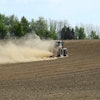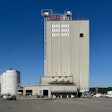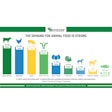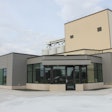At the intersection of technology and population growth, the future holds unimaginable opportunities — and likely some unprecedented challenges — for agriculture.
According to the United Nations’ Population Division, by 2050 the median global population is projected to reach 9.2 billion people — about a 30% increase from today’s population. In order to meet global food demands, the Food and Agriculture Organization (FAO) estimates the need for a 70% increase in farm production and an additional 61 million hectares of farm land.
Developing countries will account for much of the population surge, a trend that will run parallel to shifting economic growth and the emergence of a culturally defined middle class. While definitions of wealth are adjusted relative to the nation’s economy, this decades-long trend has seen the migration of 1.5 billion people from subsistence to middle income.
“We’re referring to large populations in Asia and elsewhere in the world that have gained income more than marginally and they’re demanding more variety and quality in their food,” explains Bruce Scherr, CEO and chairman of the board, informa economics.
Historically, as emerging markets gain wealth, the population’s diet shifts from bulk grain toward high-calorie, high-nutrition foods allowed for by disposable income, logistical availability and basic technologies, like refrigeration. In this scenario, animal proteins are the commodity of choice, sending out a supply/demand ripple effect for all agricultural commodities involved in producing this high-input product.
Barring the misfortune of an unforeseen catastrophic event, U.S. agriculture should be able to capitalize on this trend if it makes the necessary investments in infrastructure, technology and sustainable business.
“The industry as a whole has already begun addressing the issue of sustainability,” says Richard Sellers, AFIA vice president of feed regulation and nutrition. “The key will be more innovation and less regulation. Sustainability affects everyone so stakeholders both within and outside of the industry are taking on this global challenge and are well on their way to finding realistic answers.”
Randall Gordon, NGFA’s vice president, communications and government relations, feels the U.S. animal agricultural industries will be well-positioned to meet a growing demand for meat protein, and that it will also present a tremendous opportunity for the U.S. grain, feed and grain processing industry.
“Ours truly is a growth industry that, given the right public policies, will have an unprecedented opportunity to feed a hungry world,” he says.
Advancements in a number of familiar practices, like traceability and biotechnology, will enable the industry to meet the productivity challenges ahead.
Technology breeds transparency
While Asian and South American populations boom, domestically, a cultural permutation will shift the way food is perceived and consumed. The American consumer of the future will be one sprung from an age of mass customization as well as agricultural awareness provided by “know your farmer” and “you are what you eat, eats” campaigns.
“There is already a heightened emphasis on foods that are natural, locally produced or functional, which is driving the industry to refine its product mix, developing traceable and transparent systems for customers,” notes Elizabeth Hund, senior vice president, U.S. Bank.
In decades to come, the disconnect between farm and fork will lessen as consumers begin to focus on product origins up and down the supply chain. Futurist Jack Uldrich predicts large corporations will drive the transparency trend to a new level.
“The large retailers care about sustainability, but not so much from an environmental perspective — though they position it that way — they want to know the farmers who supply the company are in fact a low-cost producer,” he says. “If they’re not confident the producer is managing its business in a sustainable and cost-effective manner, they will take their business elsewhere.”
As this information becomes available, consumers will begin to use the data collected from sensory technology and traceability more regularly before purchasing a food product. Uldrich predicts this will influence producers to change their practices to meet the demands of the consumers. For example, a shopper may be able to scan a package of meat with their smartphone and find out where it was raised, the ingredients of the feed it ate, and where and when it was processed.
“Producers should stay on top of this technology because it will present opportunities for small- to mid-sized operations to create niches tailored to specific audiences in a cost-effective way,” he says. “Customization made possible by [sensory technology] is going to allow innovative producers to figure out how to deliver exactly what individuals want.”
This movement will be the crossroad of modern day traceability and the customization trend ingrained in the expectations of the next generation.
Sensory overload
Traceability and data capture will not be the only benefits to advancing sensory technology; other benefits will include increased production and safety.
Production will increase as precision agriculture, the utilization of information technology to maximize the efficiency of land and minimize inputs, becomes the norm and will be brought to a new level of sophistication. The continued computerization of agriculture will be made possible by increasingly sophisticated sensors so small, reliable and inexpensive they will spark a widespread adaptation by producers of all sizes.
“It’s not unrealistic to expect that farmers will be able to afford and deploy these sensors anywhere in their field to be able to better detect the first onset of a disease or toxins growth, and detect with high level of specification the needs of the crops,” Uldrich says.
From an animal ag standpoint, the use of computer chips will allow for easy tracking and monitoring of livestock growth, health and identification. Kay Johnson Smith, executive vice president of the Animal Agriculture Alliance, noted wireless technology will also provide an efficient and inexpensive tool in accessing business-improving resources, such as disease and health information, best management practices, weather and other types of forecasting to aid in planning.
For grain handlers, sensors will be used in elevators to track grain though a facility with greater accuracy and enhance its ability to monitor grain quality by removing the human error and oversight from the equation. As sensors are deployed throughout an operation, efficiency will heighten as data is utilized for remote management.
“Grain handling facilities have already started to utilize advancements in [human machine interfaces] and sensor technologies to accurately and efficiently display and record the operational performance of their machines within the plant to improve safety and reliability,” says Johnny Wheat, senior vice president and director of 4B Components USA Ltd. Along with the Internet and mobile devices, plant managers have access to their operation from anywhere in the world.”
Biotechnology addresses food supply concerns
“Feeding a growing population is both an opportunity and an obligation for the U.S. food and agriculture industry,” says Joel G. Newman, American Feed Industry Association’s (AFIA) president and CEO. “This is a watershed moment for the industry. As leaders in developing and implementing new technologies, we will make the necessary improvements to meet the challenge.”
All bets are on biotechnology to feed future populations while minimizing the impact on the environment. In addition to crop protection, GMOs, or genetically modified organisms, are credited for gains in average global yields. Industry leaders are optimistic that advancements in the field of genomics will continue to transform agriculture in major and unexpected ways.
Notably, researchers are on the verge of sequencing the genomes of a variety of different crops allowing for growth with fewer inputs, thereby decreasing the costs for producers. In addition, the cultivation of new varieties of crop to grow in areas where it was previously biologically impossible would solve land shortage issues; however, this trend would alter export and commodity markets as new crops become available regionally for the first time.
NGFA’s Gordon noted: “Advancements in crop-production technology may bring about more drought- and disease-resistant varieties that further improve yields. But thus far, production increases attributable worldwide to biotech crops have been overshadowed by production and yield gains resulting from improved plant breeding and agronomic practices. Biotech clearly can help us feed the world, but it’s not the sole answer to growing U.S. ag productivity. We also need to access more acres idled under the Conservation Reserve Program and to intensify production on existing planted acreage. As more biotech crops are authorized and adopted into production practices in more countries, productivity gains should continue.”
While research investment is essential in overcoming future production challenges, gaining the public’s support of biotechnology must also be a high priority.
“GMOs have been transformational within the industry, but the challenge is to educate and communicate the benefits of GMOs as well as to acknowledge — from a long-term impact perspective — that a lot is still unknown,” Hund says. “The industry must do a much better job in addressing this issue with the public.”
Uldrich predicts the environmental community future — especially sustainability advocates — will shift its stance on GMOs sooner than later.
“I think in the near future they will say, ‘If these GMOs require less water, less energy, fewer herbicides and pesticides — that’s a pretty good deal,’ ” he predicts. “If you start comparing those inputs to the inputs of organic crops that are very energy intensive, then from a sustainability perspective they’re going to get onboard. However, I also think the environmental community is going to fracture over this issue.”
As the scientific, economic and human imperatives make the case for GMOs, the continued advancements in genomics will need to be studied, regulated and addressed by objective parties to ensure stability of the technology and mediate safety concerns.
“I’m personally of the opinion that there are overall more net positives from genetic modification of crops, but I don’t want to minimize the risks the opposition points out,” Uldrich says. “There are legitimate concerns there, but I’m more confident our regulatory system will go to the far extreme to support these positives than I am worried about GMOs running rampant.”
GMO identification and segregation will continue to cause industry adaptation until governments lessen restrictions to allow GMOs into their food supplies. Paul Philips, Maxi-Lift’s executive vice president of sales, marketing and operations, adds: “I think people in the industry will really need to look at that and figure out how that fits with the overall needs of the world because we are the grocery store to the world.”
Biotech supporters are less concerned with whether or not the technology will be available, but more so with the ability for individuals in most impoverished nations to be able to afford to feed themselves.
Faster, bigger, better
Who better to gauge the future of the industry than those with their finger on its pulse everyday. Equipment suppliers for the grain handling and feed manufacturing industries tend to agree on one thing: The industry is shrinking.
“In the future there will be fewer players due to consolidation,” predicts Scott Chant, president of SafeGrain/Maxi-Tronic, Inc. “The companies that are left are going to be very efficient. To survive you’ll have to be on your toes to still be considered a player in the game.”
Facilities will continue to grow larger, with enhanced material handling capabilities, more automation and fewer employees. Greg Ver Steeg, vice president of marketing, Sudenga Industries, feels new software technology and advanced robotics will bring the industry to “a level of automation we can’t comprehend.”
“I think investments in automation and technology have to be the No. 1 goal of the industry,” says Mike Nelson, director of business development with Repete. “Stay as up-to-date on technology as you can because it moves so fast. If you’re not embracing tech, you’re going to get left behind.”
Mark Dohnalek, marketing director of RBHM&E, notes that the domestic regulatory environment is making some long-term shifts in facility management. “[Regulations] are forcing the industry to really reflect and invest in new areas. It has become a head wind to conducting business differently, and will no doubt continue to do so.”
As regulation influences and deters capital investments, Uldrich urges companies to internalize the idea that while certain technologies are expensive today, they will only get better, faster and cheaper.
“Just because you can’t afford certain advancement in robotics or automation today, understand all of that is getting cheaper and doesn’t mean you won’t be able to invest in it soon,” Uldrich says. “I really encourage [everyone] to the extent that they can to stay on top of the trends and prepare to make these major capital investments. The key is to figure out when the economics of bringing these new technologies in makes sense and act on that knowledge. It may make the difference between staying in business and your competition failing.”
Many factors are in play when looking at the future of agriculture and almost everything lends itself to uncertainty, but the one thing the industry can do is be prepared for whatever the future may hold. Tim Gruling, manager of sales, Agra Industries, says it best: “Keep an open mind and look at the best ways to develop and improve your business.”


















